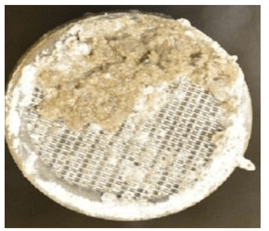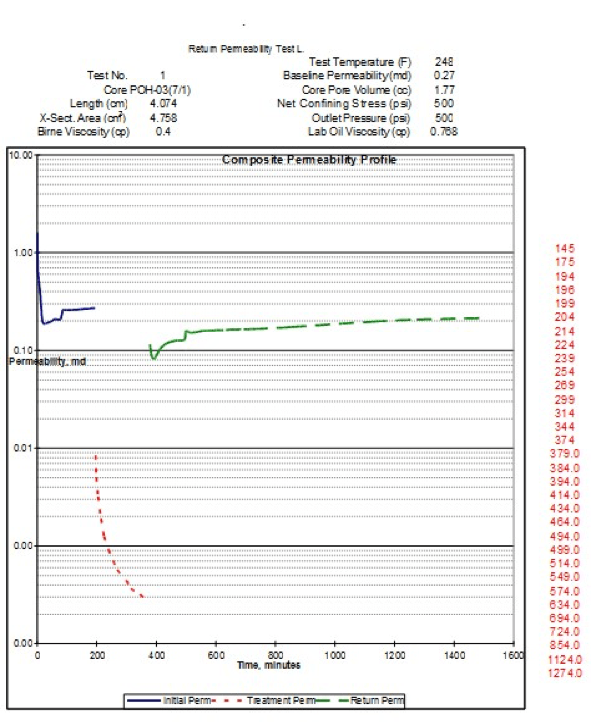Evaluating a Formation Damage Test (FDT) can be a tricky business!
 Broadly the industry understands pretty well, I think, that fluids used to drill the payzone can be damaging to the reservoir. As evidence we have the entire subset of drilling fluids known as Reservoir Drill-in Fluids, or RDF’s.
Broadly the industry understands pretty well, I think, that fluids used to drill the payzone can be damaging to the reservoir. As evidence we have the entire subset of drilling fluids known as Reservoir Drill-in Fluids, or RDF’s.
The entire objective of this fluids classification is to impart the least amount of damage to the interval as it drilled. It is in this area that I specialized in during my time at a big color fluids company. Now my mission is to pass those lessons along through these articles and in dedicated classes.
Over the last twenty-odd years the interest and focus in this area has increased tremendously, driven in no small part by the increased number of openhole completions in this time. Now virtually every service company has an offering in this space. One thing that we don’t do very well is train people to properly design, test, and interpret the results. That’s where I come in.
One of the first things I tell my students is, when it comes to evaluating the suitability of a candidate fluid there are no easy answers. If you think you have one, it is often something that will come back to bite you.
One of the ways these fluids are tested and qualified for the reservoir lies in what the industry has come to call the- Formation Damage Test (FDT). The FDT is at the end of the fluids development path, and typically results after 4-6 months of preliminary testing. Why do we wait? Because, of course, this test is done on formation core-a very rare commodity and dragged out of the earth at great expense.

The end result of this test is called a Return Permeability (RPT) number; which represents a numerical change, expressed as a percent in the flow characteristics of the rock after exposure to the candidate drill-in fluid.
This is a great day…
… If the number is close to 100.
It means the technical staff involved in designing the fluid has done their job, and delivered a suitable fluid design to the client. Maybe, maybe not. Regardless, high fives ensue, and it’s time to celebrate at the pub, or maybe just move on to the next project.

But, what if the number is less than that? Maybe way less than that, as it more often not is. It must be the ‘mud’…right? It’s always the mud. What else could it be?
That is the point of this article.
It’s not always the mud.
I was once working with a biopolymer mud on a project that seemed to be reacting badly with the formation. These muds are used routinely to drill openhole, horizontal wells, some variant of this mud type probably accounting for half the total openhole footage drilled (SWAG). In FDT testing it’s common to see RTF numbers in the high 70’s to low 80’s, when the mud, RDF is properly designed.
In this case, we had had a good preliminary round of testing-developed a mud that contained acid soluble solids that sealed of the reservoir face very quickly, and had a low total HPHT fluid loss profile. A Return to Flow (RTF) test on synthetic media had shown a break-through pressure < 3 psi, and almost complete liftoff of the filtercake with continued flow. My team was a pretty happy bunch headed into the FDT, and had treated ourselves to a trip to the pub in advance. Then the (contract) lab sent us the FDT test and our jaws dropped. RTF numbers on the cores ranged from about 10% to 96%.
Something was seriously amiss here.
We did a two week redesign, assuming that the pore throat openings were different from what we had been told. I bet you can relate to that…being told one thing, and finding later it was a lot of b.s. We cheerfully mixed up some mud that contained a redesign of bridging solids and sent it off to the lab. It was universally agreed by the team that we’d wait to go the pub until after we’d heard back.
Good thing. It got worse. Some of the cores were completely blocked; zero RTF.
The client was seriously unhappy and wanting answers. Who can blame them? I began working more closely with the contract lab-they were under some of the same pressure we were, and began to compile a history of the testing done at the lab and one thing began to stand out. See if you can figure it out before reading on.

Figure it out?
Don’t blame you. It took us awhile, like six more months of testing and a lot of AM/PM telecons (you know the kind where the tech staff doing the testing are on the other side of the planet) to get to a happy place. But, internally we had an idea of what was going on in this test.
Framework grain movement and subsequent fines migration.
This loosely consolidated sand did not have enough lithification to withstand the differential pressure of the test-500 psi, and although placed in a sleeve, shifted during the test. Fines (tiny bits of reservoir material-clays, rock fragments, etc. that cling to the pore throats) were then detached from the pore walls and flowed freely in the direction of flow, mixing with the mud filtercake and stimulation treatment.
When formation fines are mobilized it almost always results in a reduction in the flow capacity of the reservoir. It can be the result of a reaction with components of the RDF filtrate, destabilization as a result of losses, or perhaps in the production mode by drawing too hard on the well. In this case, and demonstrated to the client, in a modified test, the mobilization of the fines was an artefact of the test, and not related to the mud chemistry.
I recently related this ‘war story’ to a good friend, Dr. Dave Underdown (recently retired from Chevron as a Global Completions Advisor, and twice a SPE Distinguished Lecturer on the topic of the effect of fines on production), and he wasn’t surprised at our conclusions and mentioned, in telling a ‘war story’ of his own that, “the subject of fines migration is the focus of a lot of intense investigation,” in the industry.
So let’s sum up. What can you learn from this overview?
- It’s not always the mud. Most of the time, yes. But, not always. Keep an open mind on this topic.
- Think about how your FDT test is going to be set up. Is it appropriate to the rock you are studying? Time spent here may accrue to your benefit in the long run. Not really understanding the suitability of the core to the test as designed, and wrongly focusing on the RDF cost this client nearly a year of delay on their project.
- Learn all you can about reservoir drill-in fluids and testing them. Talk to experts. Make you understand what they tell you. Take courses. I know training money is tight, or non-existent now. I would argue that for something as critical to the success of your project as an RDF is, a few grand for a course is money well spent. FDT testing is a bit of an arcane science now. Don’t let it stay that way. It’s your well.
Thanks and a hat-tip to Dr. Dave Underdown for reviewing this article prior to it being submitted for publication. He is one of the ‘long ball hitters’ in the Formation Damage business, and I am grateful for his advice and support!








Great points Dave! Fine’s migration can certainly cause issues. I would also like to add that in formation damage testing, the actual apparatus and the methods used can affect the results. Some cannot get enough flow rate to properly displace the DIF prior to breaker placement and core prep and pressures used can also alter the results. Point here is that it is critical to take a close look at the entire procedure as not all return perms are created equal.
Clark, thanks for reading and commenting. Agree wholeheartedly with your points. The totality of the process design and type and condition of the equipment can all play a role in the outcome. I may get into this in future articles.
Hi Dave,
Thanks for the interesting article!
Where the fines in this case soluble? I am thinking if the fines were soluble, then mineral dissolution open flow paths/channels and increase the extent of penetration. This is of course, non-desirable for drilling. (Oil recovery and displacement will like this)
I was wondering if could throw more light of the type of core and laboratory set up. As Clark Harrison said, ‘it is very important’
Is it possible to hold or maintain the pore structure/damage to observe the migration and pore throat-reduction?